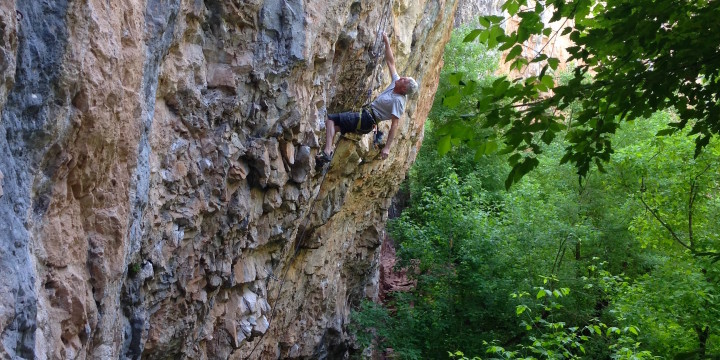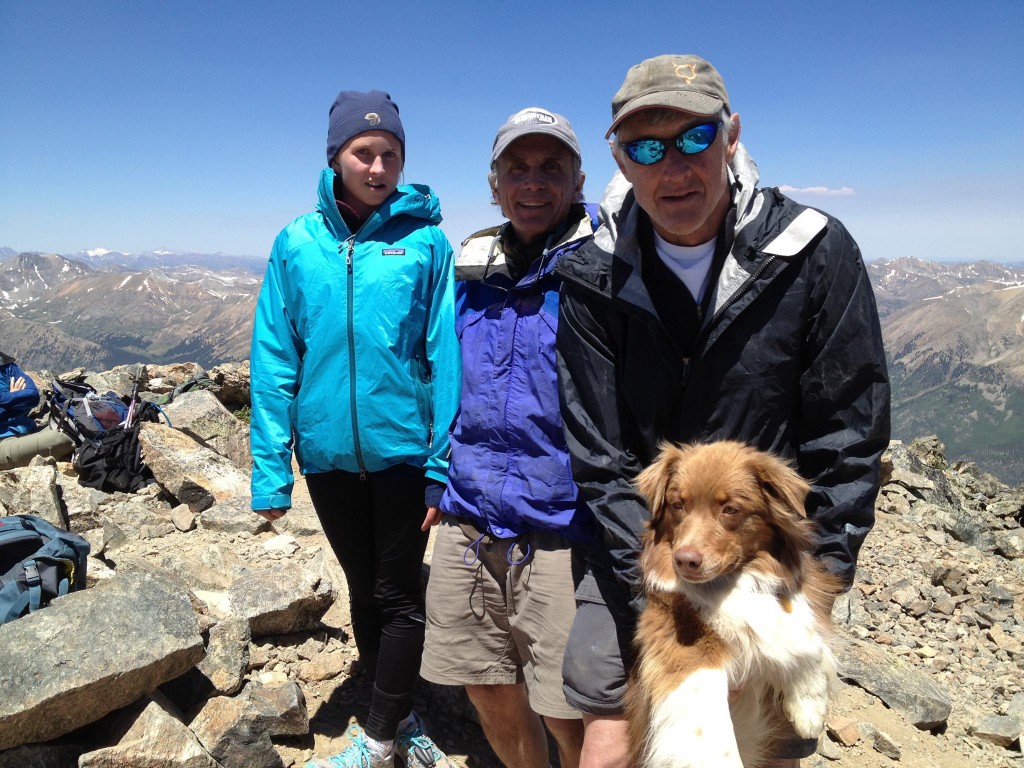
Climbing, Hip Replacements and Age
Hello from a crone! I climbed in Yosemite Valley, British Columbia, and the UK during the early 70s. After living La Vida Dirtbag, I went to university, worked, had a bomber daughter, and am now retired. In the last four years after two hip replacements due to the grinding punishment of long distance running in my 40s and 50s, I have returned to climbing both outside and at our local indoor gym as a fresh 60 year old. It has been a joy to rediscover my great love, however, I must heed to movement limitations of my lower body. I am wondering if you have ever met, climbed with, taught anyone with joint replacements? If you have, were any of these bionic folks able to go beyond a 5.9 lead, which I dearly wish to achieve? And, have you been witness to powerful climbing women in their sixth decade? Thanks so much! Granny Grace
Hi Grace,
I forwarded your question to my friend Lee Sheftel, who wrote a very inspiring post about climbing and age limits a few years back. Lee is now 69, and he crushes 5.13 at Rifle, no less, so he is a huge role model for all of us! He’s also had hip surgery, and here’s what he had to say:

Hello Grace,
You brought up an issue you are having with lower body limitations since your hip replacement(s). I have had two resurfacing hip replacements and after my recovery and PT work of about a year I haven’t noticed any limitations. I feel like my hip flexibility is just as good as it ever was (never was super great anyway even in my twenties). However I was super diligent about my PT exercises and stretching and still am. My only suggestion would be to work with a professional and/or become more aggressive with breaking up scar tissue and expanding your range of motion. The hip replacement itself shouldn’t really limit your flexibility; only the build of scar tissue would be the predominant factor to my knowledge. I am 69 and still redpoint 5.13’s. Seems my limitation in terms of grades I climb is the same it always has been which is strength. Hope I have helped. Attached are two photos, one taken this summer in Maine with my wife and the other taken a couple years ago with two dear friends and my dog Ruby on La Plata Peak- a 14er. My hips were replaced in 2007.
Lee









I think there is a very important difference in the two cases: Grace had total hip replacements (traditional total hip arthroplasty) & Lee had resurfacing. Both are impressive climbers! For climbing, hip flexion is a crucial issue. With total hip replacements, deep flexion with internal rotation is prohibited due to the dislocation risk (we shouldn’t do that combo!). The literature suggests that a larger femoral head increases the range of motion. Women are more likely to receive smaller femoral head sizes (e.g. 28mm) and this can be limiting. In contrast, my new femoral head is 40mm which allows 122 degrees of flexion. Also, the angle of the acetabulum (cup) positioning affects the range of motion. My surgeon knew of my climbing and climbing plans and this was taken into consideration. I hope this provides some insights. Each case differs. Caveat lector: I’m just a total hip replacement climber with some knowledge of the literature.
I have had both hips replaced, one when when I was 55, the other at 58. I have difficulty with high steps; my replaced hips are just not as flexible as my original hips. I have been told I don’t have any restrictions and that I don’t need to worry about dislocation. As you said, each case differs.
I’m 49 and have one total hip replacement (and will have to have the other done in a few years). I’ve been working at it most of this season, a year after my surgery, starting in February at 5.6/5.7, and have just managed to lead a few 10a and 10b routes. I don’t work out or rehab has much as I should, but I do some. I have a hard time with moves that require left leg high steps, my toes pointed in different directions, or wide stems, but I have developed some weird sequences to avoid them most of the time. Surfing doesn’t hurt at all anymore, and I’m really happy about that. Oh, I also have a hard time keeping my balance in talus fields, especially coming down. Considering that I couldn’t climb AT ALL before the hip replacement due to crucifying pain (like somebody burning inside my hip with a blowtorch), and that I was really having to grit my teeth to surf, I must say that I’m pretty happy with where I’m at right now. Sure, I’d like to be cruising 5.11 cracks like I could in the old days, but there’s nothing wrong with 5.8, either. Some of them are pretty sweet. In fact, they’re all pretty sweet. It’s so great to be outside, climbing again.
You guys! And, Steph and Lee – you guys! Thanks for your thoughtful responses, a curriculum I’m soaking up and reveling in. What Paul mentions is true for me, traditional bilateral hip replacements require absolute, non-negotiable movement restrictions. The last thing I want to undergo is the horror of dislocation, whether on a crag or taking a twisty, torque down the stairs at home. Fortunately, here in Santa Cruz California, we are blessed with having a ratio of one skilled bodyworker to every two citizens and have availed myself of these benefits. Thus, the work of breaking down scar tissue is ongoing.
Here’s the deal – I want to take the lead belay climbing series at my gym, but tone of the prerequisites is the ability to achieve consistent 5.10a climbing. Many of the moves involve my leg and foot flung high, and that would result in a drama-filled dislocation, the associated humiliation, and a death glare from my badass Stanford School of Medicine orthopedic surgeon. Dislocation fears aside, even if I were to manage such moves, I would incur cumulative wear and tear on my fake parts.
I’m going to try this strategy: Work hard on my 5.9s for the rest of 2015 and enjoy the heck out of them. Try 5.10 moves here and there. Hopefully, I will achieve competence on mixed 5.9 and 5.10a climbs. Then, work on 5.10a into 2016. The lead belay lines at our gym have easier holds sprinkled in here and there, so I will present my creds that I can mix it up, but can’t go any further because of movement restrictions. I’ll bring a note from my doctor, if I must!
So, it’s the “weird sequences” that work for you, my bionic hip friend? Also, I hear you on the talus fields, once my great delight to bounce from rock to rock, now a temptation I cannot entertain. Moderate outdoor climbing, a sweet cruise multi-pitch on a perfect Autumn day is a gift from all the gods.
Yup, Paul. Another thing – my entire yoga practice took a radical turn. Fortunately, my yoga teachers provide excellent adjustments in potentially dangerous asanas so I can stay in sequence. Hey, want to see my x-rays? My family recoils in terror looking at my metal. The grandkids, however, can’t get enough of them!
Not a snarky question – Lisa, what is it about your replacements that allow you to move without restrictions? Is it the type of joint materials? Or, how your surgeon accessed your hips during surgery?
Grace, I think I don’t have any restrictions because my surgeon used the anterior approach. As I understand it, there is less danger of dislocation if the anterior approach is used because no muscles are cut when the hip joint is approached.
My only restriction was post surgical when I was not supposed to extend my leg behind me, as you do in a lunge. After six weeks that restriction was lifted.
Grace, I have to make adjustments when I practice yoga. For example, I have to sit on a small pillow or pad, because of my inflexible hips. But I notice many folks really should make some adjustments to improve their alignment.
Pre-surgery x-rays can also be troubling 😀 I dragged this leg up Kor-Ingalls before surgery. I am happy with the new hardware.
Shout out from another Santa Cruz climber! Hope you enjoy rocking those 5.9s this year 🙂
Woot, Sarah! Thanks! If you’re ever at Pacific Edge, say hi! xo
Gnarly!
thanks for sharing the knowledge!
I just had a total hip replacement done with the anterior approach with a slightly larger ball, 38mm. I am 33. I used to climb 5.13, errr (5.12+) and do climbing expeditions around the world back in the day. Pretty bummed out about the whole thing, but so it goes and I am just thankful I didn’t break my back in my snowboarding accident and I will be able to walk without pain. However, my goal is to climb El Cap again. Good goal, but man would it be a bummer to dislocate my hip a couple thousand feet up the wall… I guess, the right approach (anterior) enlarged ball, and proper PT and scar tissue work is the formula. Just beginning my journey, as my surgery was less than a week ago.
The three year progression of my hip starting with the upper left after breaking my femur, then the avascular necrosis which killed the bone and they removed the hardware hoping to do a resurfacing, to the upper right with a total hip replacement. Issue with resurfacing is the potential metal on metal reactions. I didn’t have enough bone left for a resurfacing.
Those are scary looking X-rays (except for the last one with new hip).
Asa, I know my surgeon used as large a ball as he could with my hip replacement, but as I am a female with a shallow hip socket he had to deal with some limitations.
I strongly suspect that you will be able to climb EL CAP again. Take PT seriously and you will get there. Good luck!
I recently had the misfortune of having to under a pretty intense hip replacement. I had to undergo some reconstructive surgery in order to correct a severe trauma. The whole process leading up to the surgery was traumatic for obvious reasons. I don’t want to go into too much detail but during my surgery, my team used a FAW blanket called the Bair Hugger and it helped so much with my post surgical recovery. I credit my super quick recovery to the blanket. Here are some facts about the system http://www.truthaboutbairhugger.com